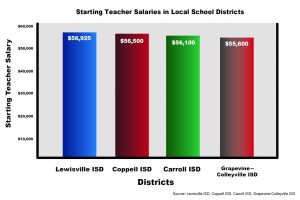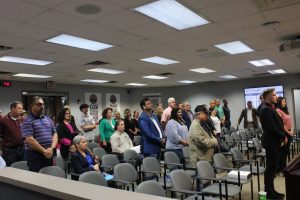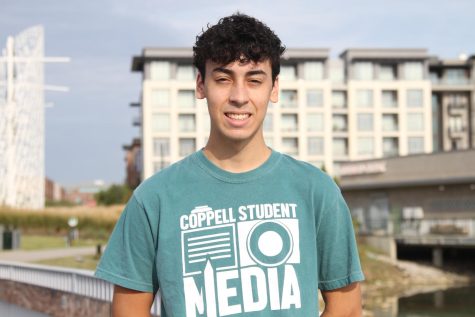Recapturing the passion for teaching
Teacher retention falling amidst stagnant wages
October 11, 2022

The early morning light creeps through large glass windows, illuminating the red and gray paneling of Coppell Middle School West. It is Saturday, but the halls are buzzing with activity.
In response to the highly advertised job fair, potential Coppell ISD staff enter the building in search of new positions beginning in the fall of the 2022-23 school year. Coppell High School Principal Laura Springer breathes a sigh of relief.
Shouldering a new set of responsibilities such as bridging the learning deficit amidst stagnant wages, many Texas teachers have left the profession to pursue jobs in other districts and fields.
“It really scares me that we have such a struggle with finding teachers,” Springer said. “They’re not in massive supply like they used to be. We used to have so many people that would apply for our jobs. This year, I had to go to every highway and byway and wherever I could to try to get our classes all covered for the year.
“It’s scary. The whole thing scares me.”
According to CHS associate principal Zane Porter, about 25% of new teachers this year were hired at the job fair. Currently, six new teachers are in alternative certification programs, one of them being forensics teacher Joshua Henderson. These programs offer a flexible pathway to becoming a teacher by allowing one year in the classroom with a degree as they complete their teaching certification.
While pursuing a career in nursing, Henderson waited tables at a local restaurant where Springer and him would occasionally cross paths. Every Saturday at 4 p.m., Springer and family would visit the restaurant and Henderson eventually established a relationship with her. After a few months, Springer began asking what Henderson wanted to pursue as a career.

“I had decided that I wasn’t thinking about nursing anymore as a long-term career, or even as a prospect at that point,” Henderson said. “I was kind of lost. I had remembered a friend was telling me about the Texas teachers alternative certification program, just to at least start doing something.”
Springer invited Henderson to the job fair and after verifying his qualifications, he was offered a job.
“[Teaching] is considered something that people don’t want to do,” Henderson said. “There aren’t enough of us, which means that some of us might have to work a little bit harder than we might have planned for.”
According to CISD chief financial officer Diana Sircar, recruitment and retention of instructional and other professional personnel has become increasingly difficult. Competition in other jobs such as custodial, transportation and school nutrition has driven up wages.
“We ask more and more of teachers and yet we’re not paying them more and more,” said Executive Director of the Texas School Coalition, which represents Recapture districts, Christy Rome. “What we see is that there are other private industry jobs that may not be as rewarding but pay as much or more than they’re making as teachers. Unfortunately, that factors into the decision of whether or not someone continues a career as a teacher. If we had additional funding for schools, the beneficiaries of that would primarily be our teachers.”
CISD recently finalized the 2022-23 budget, which saw a $9.67 million deficit. According to Sircar, about 82% of the district’s costs are payroll. For the past two school years, the district provided a 2% increase in wages to staff. This year, the Coppell Board of Trustees felt strongly that it needed to provide a higher increase. The board approved a 4% increase for teachers in 2022-23.
AP Macroeconomics and Microeconomics teacher Miranda Portteus has been teaching CHS for 11 years. She continues to stay in education because of her love for the subject that she teaches. In the last two years, she never seriously considered leaving, but the thought has crossed her mind.

“Real wages have significantly decreased with only a 2% raise,” Portteus said. “I’m not making as much as I made last year, if we talk about the change in inflation. We’ve added five minutes to the school day. And in the grand scheme of things, that doesn’t seem like a lot. But that’s an extra five minutes. I accept the wages, but I do think we should be paid more.”
In a survey conducted by the Charles Butt Foundation of a random sample of Texas public school teachers, it was found that 77 percent have seriously considered leaving the profession, which is up 19 percent in two years. Seventy-two percent have taken concrete steps to do so. One of the major factors is pay. Eighty-one percent of Texas teachers say their pay is unfair, up 12 points in a year.
“In that industry, it doesn’t matter how hard you work,” former CHS soccer coach James Balcom said. “You could just show up, do your job and leave, or you could be somebody who pours into the kids and spends an hour or two in the morning and at the end of the day. You’re going to make the same amount as somebody who just kind of shows up. Over time, you just see how your hard work and your energy almost doesn’t matter. And that’s, it’s tough to say, the kind of [mentality] where I got to as an educator.”

Balcom left the teaching and high school coaching profession at the end of the 2021-22 school year and now works as a vice president of a roofing company. He continues to coach with Solar Soccer Club. Balcom does not see himself returning to education.
“Coaching stipends in Coppell and many places in Texas haven’t increased at all,” Balcom said. “The last few years have been really upsetting. Being a head soccer coach and making less money than a baseball or basketball coach didn’t make much sense to me. I tried to work as hard as I possibly could for the kids and at the end of the day, I don’t think it was ever really valued. I think people need to be paid for the work that they do. If teachers felt financially valued for the job they do, you wouldn’t see the shortages, you’d see people come back to the industry and want to keep doing it.”
Teacher compensation has long been a topic of discussion. In the Coppell, Texas Facebook Group, concerned parents question what CISD is doing with its tax dollars and why it cannot be translated to increasing teacher salaries.
The answer is the state’s Recapture program, or Robin Hood.

The Texas Legislature implemented Chapter 41 of the Texas Education Code in 1993 after a series of court rulings that said our school finance system was unconstitutional, which is now known as the Recapture or Robin Hood program. The system sought to create equity across school districts by having wealthy districts send property tax revenue to the state who then distributes the money to lower wealth districts and charter schools.
According to Rome, when Recapture first began in 1993, a couple of districts could tax property at a really low rate and get a big return, versus districts that were taxing extraordinarily high rates and not getting much to show for it. Recapture sought to equalize the funding, so that the districts had to make similar tax efforts, and get similar revenue in return.
It started with just a handful of districts to equalize. Most of those were rural, small West Texas districts because of oil and gas wealth, or small bedroom communities like Highland Park and Alamo Heights ISD.
At one point, Recapture districts grew to be about 40% of the districts in the state. It is now back down to about 20% of districts, however it affects very large districts that serve a high number of students who are in poverty.
Rome explains the system of Recapture as a glass of water. The size of the glass is determined by the state’s school finance formulas. It begins with the main building block, which is basic allotment. This is the amount that every school district is guaranteed to receive in state and local funds for each student in average daily attendance. Factors, such as student characteristics, transportation, teacher incentives and district tax rates, come together to form the district’s funding entitlement.
What fills the glass is local property tax collection. If the district cannot fill its own glass, the state fills the glass the rest of the way. In districts such as CISD, the local property taxes cause a spillover which is then sent back to the state.
“In places like Coppell, Dallas, Houston or Austin, it costs more to live,” Rome said. “The housing prices are higher – the price of goods are higher in those areas than if you were to go to more rural communities. There’s nothing in our school finance formula that adjusts for that. There is now a new kind of inequity in our system, because there’s no adjustment for the higher cost of living in some areas of our state compared to others. The buying power of the dollar, it just doesn’t go as far in our urban areas as it does in the more rural communities.”

Recapture removes $3 billion per year from Texas school districts. Compared to the state lottery which brings in $1.6 billion a year, replacing Recapture is very difficult because of the amount of money that the taxation brings to the state.
“Right now, as property values push tax payments higher, the state is reducing the amount of money that it invests in public education,” said Theresa Williams, Superintendent of Plano ISD in a press release by the Texas School Coalition. “Additional state investments in public education would help slow the growth of Recapture and benefit all schools.”
Currently, Recapture makes up 26.09% of CISD budget expenditures, which equates to more than $46 million to be returned to the state according to a press release on the 2022-2023 Budget and Tax Rate.
On July 14, the state comptroller announced an increase in the state general fund surplus of $26.9 billion, which is where the recaptured funds are going.

“How do we know that the dollars that CISD is sending back for Recapture are being distributed to other school districts?” Sircar said. “We don’t know that information. We need that kind of transparency from our state legislature to be able to show where those funds are going and how they’re supporting other districts.”
Recapture does not take into consideration the demographic of the students attending the school districts. For example, Austin ISD, where 51.9% of students are considered economically disadvantaged, pays the highest amount in Recapture in the entire state because of skyrocketing property values. According to Rome, it is not about whether or not the people who are attending the school are rich or poor. The people who live in the area do not benefit at all.
“The wealth level of the students and families in the district doesn’t factor into whether or not the district is paying Recapture,” Rome said. “It’s about what the taxes in that community bring in or don’t. There are also communities in the state where the students and families in that community may be very well off as a whole. Yet, they don’t pay Recapture at all – that’s the difference in personal wealth and property wealth.”
Despite beliefs, the tax rate cannot be lowered in order to pay less in Recapture, because if lowered past a certain threshold, the entitlement funding given to CISD would be reduced.
“Revenue per student [basic allotment] is fixed by state funding formulas,” said Sircar at the Aug. 22 CISD Board of Trustees meeting. “It does not change when our property values increase. Even though the district may be bringing in additional tax revenue, if it is in excess of the calculated entitlement, it goes back to the state in the form of recapture.”
According to the Texas Education Agency, in the 2020-21 school year, the state saw a decrease of 122,350 in public school enrollment.
“The entire state lost student enrollment during COVID,” Sircar said. “The state anticipated providing funding for a certain level of students, and when that came down lower, the state saved that money. Since our property values are going up and our tax revenue is going up, the state is recapturing more of those dollars, and perhaps doesn’t have as much to spend it on. The state foundation school program, which is the term that the state uses as far as funding school districts, has saved money over the last couple of years.”
House Bill 3 was passed in 2019 and provided more money for Texas classrooms, increasing teacher compensation and reducing Recapture. However, high inflation has outpaced the funding granted and Recapture has increased by 25% since. According to
Seminole ISD Superintendent and President of the Texas School Coalition Kyle Lynch, the bill made Recapture dip for one year, but it quickly rose again due to inflation.

Seminole ISD is a 1,000-square mile school district which has boundaries run to New Mexico.
“We run buses all over the county every day,” Lynch said. “We have kids living out in the country on farms. We budgeted for diesel a year ago, and we thought we’d be fine. And then all of a sudden, diesel [prices] go out of this world, but [school districts] still have to pick our kids up. Our costs are going up, but the funding we’re getting from the state has not gone up.”
According to a press release by the Texas School Coalition on Aug. 15, an increase in basic allotment would address all issues presented. House Bill 3 ensures that at least 30% of any increase goes toward increased teacher salaries and reducing Recapture.
If basic allotment was increased to match the rate of inflation since 2019, it would be increased by $700 up to $6,860. Every $100 increase to the basic allotment would mean roughly a $100 million annual reduction in recapture statewide.
“Recapture districts complain about recapture because that’s where a lot of money is going,” Rome said. “If you’re a district that is not a recapture district, then you complain about not having enough money from the state. It’s the same problem that is causing both of those things, it just manifests in a different way. So if the state were to provide additional funding to schools, Coppell ISD would not have to send as much away through Recapture and they’d be able to use more of it to pay their teachers, help their students and do things at the local school district level.”
Follow @angelinaliiu and @CHSCampusNews on Twitter.

















Shrayes Gunna • Oct 13, 2022 at 10:16 pm
What strong journalism! It’s evident the writer poured hours into researching the issue at hand and interviewing a variety of perspectives to give us a three-dimensional view of teacher retention in a post-covid world. How absolutely enlightening and engaging!
Jerry Liu • Mar 7, 2023 at 3:15 pm
Indeed!